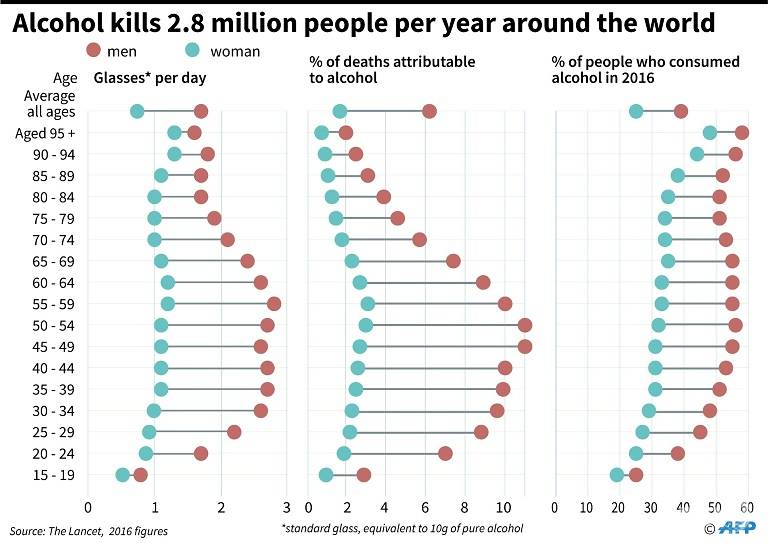"There is no safe level of alcohol," said Max Griswold, a researcher at the Institute for Health Metrics and Evaluation in Seattle, Washington and lead author for a consortium of more than 500 experts.
Despite recent research showing that light-to-moderate drinking reduces heart disease, the new study found that alcohol use is more likely than not to do harm.
"The protective effect of alcohol was offset by the risks," Griswold told AFP in summarising the results, published in medical journal The Lancet on Friday.
"Overall, the health risks associated with alcohol rose in line with the amount consumed each day."
Compared to abstinence, imbibing one "standard drink" - 10 grammes of alcohol, equivalent to a small beer, glass of wine or shot of spirits - per day, for example, ups the odds of developing at least one of two dozen health problems by about half-a-per cent, the researchers reported.
Looked at one way, that seems like a small increment: 914 out of 100,000 teetotallers will encounter those problems, compared to 918 people who imbibe seven times per week.
"But at the global level, that additional risk of 0.5 per cent among (once-a-day) drinkers corresponds to about 100,000 additional deaths each year," said senior author Emmanuela Gakidou, a professor at the University of Washington and a director at the Institute for Health Metrics and Evaluation.
'LESS IS BETTER, NONE IS BEST'
"Those are excess deaths, in other words, that could be avoided," she told AFP.
The risk climbs in a steep "J-curve", the study found.
An average of two drinks per day, for example, translated into a 7.0 percent hike in disease and injury compared to those who opt for abstinence.
With five "units" of alcohol per day, the likelihood of serious consequences jumps by 37 percent.
The "less is better, none is best" finding jibes with the World Health Organization's long-standing position, but is at odds with many national guidelines, especially in the developed world.
Britain's health authority, for example, suggests not exceeding 14 drinks per week "to keep health risks from alcohol to a low level".
"There is always a lag between the publication of new evidence and the modification and adoption of revised guidelines," said Gakidou, who admitted to being an "occasional drinker" herself.
"The evidence shows what the evidence shows, and I - like 2.4 billion other people on the planet that also consume alcohol - need to take it seriously."
Overall, drinking was the seventh leading risk factor for premature death and disease in 2016, accounting for just over two per cent of deaths in women and nearly seven percent in men.

The top six killers are high blood pressure, smoking, low-birth weight and premature delivery, high blood sugar (diabetes), obesity and pollution.
But in the 15-49 age bracket, alcohol emerged as the most lethal factor, responsible for more than 12 percent of deaths among men, the study found.
THE 95 PERCENT CLUB
The main causes of alcohol-related deaths in this age group were tuberculosis, road injuries and "self-harm", mainly suicide.
King's College London professor Robyn Burton, who did not take part in the study, described it as "the most comprehensive estimate of the global burden of alcohol use to date."
The examination of impacts drew from more than 600 earlier studies, while a country-by-country tally of prevalence - the percentage of men and women who drink, and how much they consume - drew from another 700.
Both were grounded in new methods that compensated for the shortcomings of earlier efforts.
Among men, drinking alcohol in 2016 was most widespread in Denmark (97 percent), along with Norway, Argentina, Germany, and Poland (94 percent).
In Asia, South Korean men took the lead, with 91 percent hitting the bottle at least once in a while.
Among women, Danes also ranked first (95 per cent), followed by Norway (91 per cent), Germany and Argentina (90 percent), and New Zealand (89 percent).
The biggest drinkers, however, were found elsewhere.
Men in Romania who partake knocked back a top-scoring eight drinks a day on average, with Portugal, Luxembourg, Lithuania and Ukraine just behind at seven "units" per day.
Ukrainian women who drink were in a league of their own, putting away more than four glasses or shots every 24 hours, followed by Andorra, Luxembourg, Belarus, Sweden, Denmark, Ireland and Britain, all averaging about three per day.
The most abstemious nations were those with Muslim-majority populations.
Source: AFP/ec







